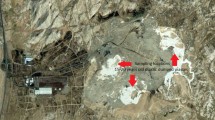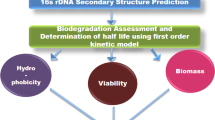Abstract
Polyethylene represents nearly 64% of all the synthetic plastics produced and are mainly used for domestic and industrial applications. Their extensive use poses a serious environmental threat because of their non-biodegradable nature. Among all the polyethylene remediation strategies, in situ bioremediation happens to be the safest and efficient one. In the current study, efforts had been given to compare the extent of LDPE degradation under UV-treated and UV-untreated conditions by soil microcosm. Landfill soil was collected and UV-treated and UV-untreated LDPE were added separately to the soil following incubation under similar conditions. Electron microscopic images as well as the weight loss and the tensile strength results clearly revealed that UV-treated LDPE showed better degradation than the non-treated ones in soil. To elucidate the mechanism of this enhanced biodegradation, the bond spectra of differentially treated LDPE were analyzed by FTIR. The results obtained from bond spectra studies revealed that UV treatment increases both carbonyl and terminal double-bond index of the LDPE, thereby making it highly susceptible for microbial degradation. Moreover, incubation of UV-treated LDPE with soil favors better adherence of metabolically active and significantly higher number of microorganisms on it. Taken together, all these results demonstrate the higher microbial association and their better metabolic potential to the UV-treated LDPE that lead to enhanced degradation of the LDPE by the soil microorganisms.





Similar content being viewed by others
References
Abraham, J., Ghosh, E., Mukherjee, P., & Gajendiran, A. (2017). Microbial degradation of low density polyethylene. Environmental Progress & Sustainable Energy, 36(1), 147–154.
Anonymous, Central Pollution Control Board (CPCB). (2013). Material on plastic waste management. New Delhi: CPCB (http://www.cpcb.nic.in/divisionsofheadoffice/pcp/management_plasticwaste.pdf).
Balasubramanian, V., Natarajan, K., Hemambika, B., Ramesh, N., Sumathi, C. S., Kottaimuthu, R., & Rajash, K. V. (2010). High-density polyethylene (HDPE)-degrading potential bacteria from marine ecosystem of Gulf of Mannar, India. Letters in Applied Microbiology, 51(2), 205–211.
Chatterjee, S., Roy, B., Roy, D., & Banerjee, R. (2010). Enzyme-mediated biodegradation of heat treated commercial polyethylene by Staphylococcal species. Polymer Degradation and Stability, 95, 195–200.
Dacko, P., Rydz, J., Sikorska, W., Sobota, M., & Kowalczuk, M. (2008). Industrial composting of polymer based materials produced from recycled materials. Problemy Ekologii, 67, 39–42.
Esmaeili, A., Pourbabaee, A. A., Alikhani, H. A., Shabani, F., & Esmaeili, E. (2013). Biodegradation of low-density polyethylene (LDPE) by mixed culture of Lysinibacillus xylanilyticus and Aspergillus niger in soil. PLoS One, 8(9), e71720.
Gajendiran, A., Krishnamoorthy, S., & Abraham, J. (2016). Microbial degradation of low-density polyethylene (LDPE) by Aspergillus clavatus strain JASK1 isolated from landfill soil. 3 Biotech, 6(1), 52.
Gomes, H. I., Dias-Ferreira, C., & Ribeiro, A. B. (2013). Overview of in situ and ex situ remediation technologies for PCB-contaminated soils and sediments and obstacles for full-scale application. Science of the Total Environment, 445, 237–260.
Hadad, D., Geresh, G., & Sivan, A. (2005). Biodegradation of polyethylene by the thermophilic bacterium Brevibacillus borstelensis. Journal of Applied Microbiology, 98, 1093–1100.
Killham, K., & Staddon, W. J. (2002). Bioindicators and sensors of soil health and the application of geostatistics. In Enzymes in the environment: activity, ecology and applications (pp. 391–405). New York: Marcel Dekker.
Koelsch, F. (2007) Stability problems of landfills—the Payatas landslide. In Proc., 17th Int. Conf. on Solid Waste Technology and Management (pp. 1–7).
Lee, B., Pometto, A. L., Fratzke, A., & Bailey, T. B. (1991). Biodegradation of degradable plastic polyethylene by Phanerochaete and Streptomyces species. Applied and Environmental Microbiology, 57(3), 678–685.
Lowry, O. H., Rosebrough, N. J., Farr, A. L., & Randall, R. J. (1951). Protein measurement with the Folin phenol reagent. The Journal of Biological Chemistry, 193, 265–275.
Orr, I. G., Hadar, Y., & Sivan, A. (2004). Colonization, biofilm formation and biodegradation of polyethylene by a strain of Rhodococcus ruber. Applied Microbiology and Biotechnology, 65(1), 97–104.
Otake, Y., Kobayashi, T., Ashbe, H., Murakami, N., & Ono, K. (1995). Biodegradation of low density polyethylene, polyvinyl-polyvinyl-chloride and urea-formaldehyde resin buried under soil for over 32 years. Journal of Applied Polymer Science Symposium, 56, 1789–1796.
Potts, J. E. (1978). Biodegradation. In H. H. G. Jelinek (Ed.), Aspects of degradation and stabilization of polymers (pp. 617–658). New York: Elsevier.
Singh, J., & Gupta, K. C. (2014). Screening and identification of low density polyethylene (LDPE) degrading soil fungi isolated from polythene polluted sites around Gwalior City (MP). International Journal of Current Microbiology and Applied Sciences, 3(6), 443–448.
Soni, R., Kapri, A., Zaidi, M. G. H., & Goel, R. (2009). Comparative biodegradation studies of non-poronized and poronized LDPE using indigenous microbial consortium. Journal of Polymers and the Environment, 17, 233–239.
Teng, Y., Luo, Y., Sun, M., Liu, Z., Li, Z., & Christie, P. (2010). Effect of bioaugmentation by Paracoccus sp. strain HPD-2 on the soil microbial community and removal of polycyclic aromatic hydrocarbons from an aged contaminated soil. Bioresource Technology, 101, 3437–3443.
Tribedi, P., & Sil, A. K. (2013). Low-density polyethylene degradation by Pseudomonas sp. AKS2 biofilm. Environmental Science and Pollution Research International, 20, 4146–4153.
Tribedi, P., Gupta, A. D., & Sil, A. K. (2015). Adaptation of Pseudomonas sp. AKS2 in biofilm on low-density polyethylene surface: an effective strategy for efficient survival and polymer degradation. Bioresources and Bioprocessing, 2(1), 14.
Zahra, S., Abbas, S. S., Mahsa, M. T., & Mohsen, N. (2010). Biodegradation of low-density polyethylene (LDPE) by isolated fungi in solid waste medium. Waste Management, 30, 396–401.
Acknowledgements
We do express our sincere gratitude to the learned reviewers and eminent editor for their efforts towards the betterment of our current work.
Funding
This work is fully supported by a grant-in-aid from the Assam Science Technology & Environment Council (ASTEC) (Department of Science and Technology, Govt. of Assam, India) (Sanction Number: ASTEC/S&T/192(157)/2015-2016/3933).
Author information
Authors and Affiliations
Corresponding author
Ethics declarations
Conflict of interest
The authors declare that they have no conflict of interest.
Electronic supplementary material
Supplementary Figure 1
(DOC 1016 kb)
Rights and permissions
About this article
Cite this article
Tribedi, P., Dey, S. Pre-oxidation of low-density polyethylene (LDPE) by ultraviolet light (UV) promotes enhanced degradation of LDPE in soil. Environ Monit Assess 189, 624 (2017). https://doi.org/10.1007/s10661-017-6351-2
Received:
Accepted:
Published:
DOI: https://doi.org/10.1007/s10661-017-6351-2




